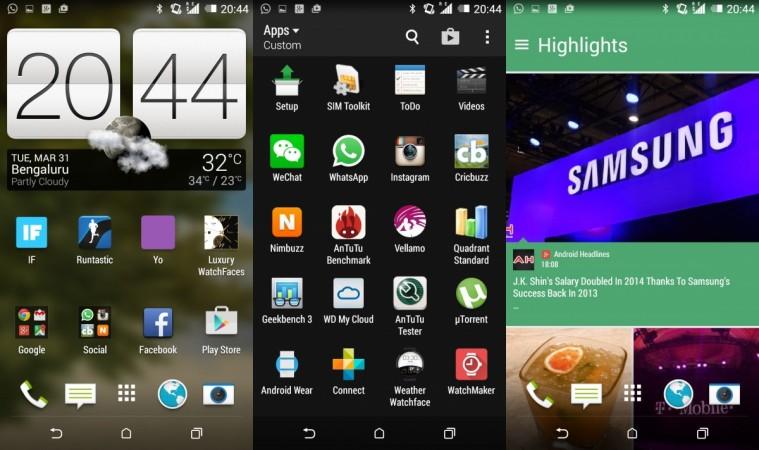
HTC has released several smartphones in various prices ranges since last year, which in turn has boosted their position in the middle tier market.
This year it has launched noteworthy devices like 526G for the budget conscious customers and the latest Desire 820S for the mid range consumers. Inheriting the form factor of HTC desire 820, the 820S packs powerhouse specification to achieve outstanding scores. The price-to-performance ratio makes the phone really competent among its competitors in the similar price range.
Built & Design
To start with this section, we must admit that HTC is one of the companies that can compete with Apple and Samsung when it comes to design. For the HTC Desire 820S, the firm has picked good quality plastic materials to give it a sleek, sturdy yet impressive finish.
However, the dual colour preset may not be eye catching to everyone, especially a buyer who likes a serious business looks on their phone. But otherwise Desire 820S looks quite impressive for the dual white blue tone. The texture has been blended perfectly to give the smartphone a solid look and feel.
The right hand physical power and volume buttons feels reasonably well constructed and are suitably sensitive and responsive.
Thanks to the 157.7 x 78.74 x 7.74 mm dimensions, 155g weight and rounded corners for making the Desire 820S comfortable in hand. The only design qualms we noticed is the two nano SIM and Micro SD card slots on the left side. The quality of plastic used looks cheap and could have been better.

Display
The Desire 820S features a fairly large display by the manufacturer's standard and comes with a 5.5-inch, 720x1280 pixels HD display.
Though you can expect a FHD display in the offered price, we found the Desire 820S's display fairly impressive. The display offers great readability with ample brightness and contrast level, and unlike numerous smartphones in the range it doesn't over saturate colours. On a good note the display remains quite readable under direct sunlight. We also found the viewing angles of display fairly impressive.
Software
The Desire 820S runs Google's previous generation OS version Android Kitkat 4.4 overlaid with a HTC Sense 6.0 user interface.
The latest Android 5 Lollipop has several advantages including performance overhaul and battery life improvements over its predecessor, and hence we wish the Desire 820S will have the same as an OTA upgrade.
HTC has already confirmed number of devices which are going to get the worthy update and till filing the review Desire 820S found itself in it.
However, the Sense 6.0 UI offers nifty features like Motion Launch and BlinkFeed services. The Motion Launch feature allows users to return straight to the home screen from the locked screen by swiping left.
The BlinkFeed is a news aggregator service to replace the native Android screen. The feature is a great tool to get all the news and get all the key updates while the user is on the move.

The Desire 820S is powered by an Octa-Core 1.7GHz ARM Cortex A53 64bit chipset MediaTek MT6752 and ARM Mali T760 GPU with 2GB worth RAM memory.
The specifications are reasonably impressive for a mid range smartphone. On our test, the Desire 820S achieved 44,198 in AnTuTu Benchmark 5.6.2, fair enough for a mid range smartphone where anything above 35,000 is considered as great. In Quadrant Standard test Desire 820S managed 17,393. In the GeekBench single core test it managed to achieve 808 and in Multi-core it scored 3808. More impressively, the Desire 820S managed to score 1857 by beating the HTC One M8, OnePlus One, Samsung Galaxy S5 and of course Xiaomi Mi4.
In our real world use test, the Desire 820S performed reasonably well. We never experience any lag while dealing with multiple web pages and apps together. In our game testing session the device stood on the same by providing us a flawless experience.
Camera
The Desire 820S offers a 13-megapixel sensor with autofocus for the rear and a 8-megapixel sensor for the front.
Both the camera performs reasonably well by focusing rapidly on the subject. The result images are really impressive and crisp with decent contrast and colour balance. Our experience remained the same with the front camera too, which helped us to click some reasonably well selfies. In low light, the 820S managed to achieve some good clicks too.
The stock camera interface is simple in use and sticks to its basics. If you want to be little artistic with the result images, download a third party app, which allows more customisation options and filters.
Battery and Storage
Battery life is a major concern for the smartphones. Nothing is optimum for the modern ultra sharp displays and power hungry processors. But in Desire 820S we found the featured 2600 mAh battery decent enough. The non removable battery managed to achieve over a day, which is impressive. On a positive note, the Desire 820S also survived little less than 8 hours in our infinite video loop test.
In terms of storage the Desire 820S comes with a basic 16GB of internal space, although it can be extended 32GB further by using a micro SD card.
Wrapping Up
The Desire 820S features a decent design, decent quality cameras and decent enough performance in its price.
Talking about the flaws, the average screen and previous generation Android counted as a letdown for it. But considering other competitors in its price, there are very few Android Lollipop options available in its price.
Considering the pros and cons at the same price in the Android ecosystem, the Desire 820S is a solid smartphone to buy.













